Chapter two: Participatory assessment
Chapter three: Participatory assessment
Chapter four: Participatory monitoring
Chapter five: Participatory evaluation
Chapter six: Information analysis
Chapter seven: Presentation of results
A method is a way to go about planning, organizing and carrying out an activity or group of activities.
In forestry, we are familiar, with planting methods, pruning methods, thinning and harvesting methods. Each of these describes a way to go about performing a certain activity at a certain time. Each of these activities contributes to the realization of an established tree, or a whole woodlot.
The methods of PAME are also distinct in what they do, and when they are done. Each method contributes to the whole information system, just as a thinning method contributes to the whole woodlot! The methods of PAME are:
| Participatory Assessment | Chapter Two |
| Participatory Baselines | Chapter Three |
| Participatory Monitoring | Chapter Four |
| Participatory Evaluation | Chapter Five |
Each chapter first describes the method, and its main purposes. Following this, the benefits of the method are listed. Finally, steps to help organize the information gathering are described.
It is expected that the methods may need to be modified during the process of field experimentation, according to the community response and existing community skills.
Chapters Six and Seven introduce some of the ways to analyze information and present results.
Chapter two: Participatory assessment
1. What is participatory assessment?
2. Benefits of participatory assessment.
3. Steps to participatory assessment.
1. What is participatory assessment?
Participatory Assessment is a method for determining, from the insiders point of view: what activities are needed and can be supported; whether insiders accept the activities proposed by outsiders and; whether the activities are reasonable and practical.
Insiders, facilitated by outsiders, go through a process in which they identify the conditions that are necessary for successful completion of activities, and gather information to determine whether or not their community has these conditions or can create them. An "Assessment Framework" examines each activity in terms of necessary conditions and eliminates those activities which do not have necessary conditions.
Decisions may have already been made by outsiders
Often the way that activities are planned can mean that some decisions have already been made without input from the community. It may be:
• that the problems and the solutions to the problems have been established by outsiders,
• that funding has been decided upon,
• that the national or local governments have negotiated with outsiders or, in some cases, have initiated the project,
• that the area within a country has been determined and that field staff have been assigned specific roles.
Activities can be initiated by outsiders
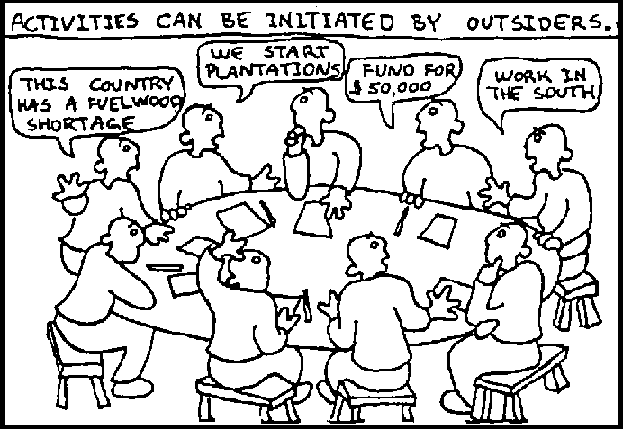
One of the decisions often left to field staff is the choice of communities in which to carry out activities. For example, in a designated area, there may be a great many communities in which activities could be introduced. But there may be field staff constraints, such as lack of vehicles and trained field staff, which make serving some communities difficult. Field staff will have to consider their own abilities and constraints. As well, they will have to consider which communities have both the problem that the activities address and the physical and community conditions necessary for success.
If field staff must choose communities, a modification of the Participatory Assessment method that is described in this chapter can help them decide which communities to approach.
Participatory Assessment when activities initiated by both insiders and outsiders
In community forestry, insiders provide many of the inputs, such as labour, materials, and management. While the outsiders may have chosen the community as having the conditions necessary for activities to succeed, the insiders will not always agree; they will have to decide for themselves.
Participatory Assessment provides a framework for insiders and outsiders to determine whether or not they want, need, and can support the activities proposed.
Participatory Assessment when activities initiated by insiders
When insiders approach outsiders for assistance with activities, a Participatory Assessment can be very useful. It can confirm to insiders that they have identified the right problem and the right solutions. It can also help outsiders understand the proposed activities and why the community has chosen them.
Community are not always harmonious
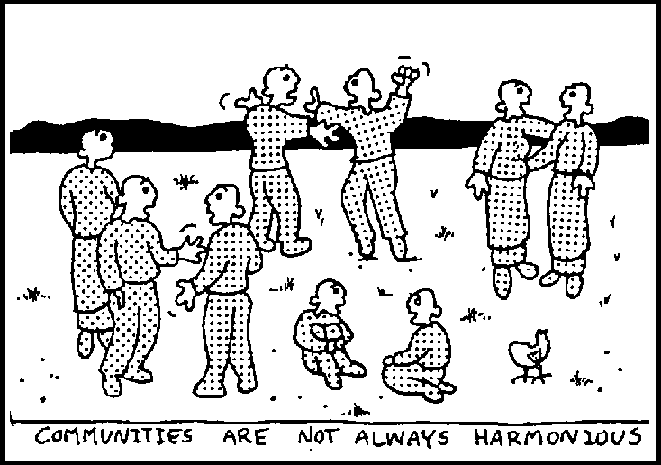
Participatory Assessment is facilitated by outsiders
An insider assessment may be something that has not been done before. It may be a learning experience for everyone!
As facilitators, outsiders openly discuss what they can offer to the community. This may be material resources that the community does not have, such as seeds or shovels. It may be technical or organizational advice. Outsiders also communicate to insiders that the decision to accept, modify or reject proposed activities is a decision insiders must consider carefully. After all, potentially they have the most to lose if the activities fail and the most to gain if they succeed.
Many objectives are considered
To ensure, as far as possible, that everyone receives what they want and need, Participatory Assessment considers all relevant objectives. The objectives of insiders who may directly benefit, those of insiders who may indirectly benefit, and those of outsiders are all identified and considered. Participatory Assessment encourages discussion of all objectives, thus it can help identify conflicting and complementary objectives.
Even when the objectives of insiders and outsiders are different, often with slight changes, everyones objectives can be achieved. In the following example, where outsiders have proposed community woodlots, there are three "sets" of objectives that must be considered.
| Outsider objectives: | To maintain a sustainable fuelwood supply for the landless poor. |
| Insider objectives: (people with land) | To reduce soil erosion by wind. To obtain more fodder for their livestock. |
| Insider objectives: (landless people) | To continue to collect fuelwood from the surrounding area. |
Are these objectives in conflict? If outsiders objectives are met, does this mean that the objectives of insiders with land will not be achieved? Can something be done so that all objectives are met to some degree?
Addressing conflicting objectives is possible. One solution might be to change activities. Instead of community woodlots, landless people could plant coppicing fuelwood and fodder species on private farmland.
Modification of the activities would meet the objectives of the insiders with land by providing windbreaks to reduce soil erosion, and increasing the fodder supply in the community. The objectives of the landless could be achieved by their planting and managing the windbreaks by selective cutting, so that the windbreak effects would always be present, and yet they could obtain a steady supply of fuelwood, as well as collect and sell the fodder.
Even with different objectives
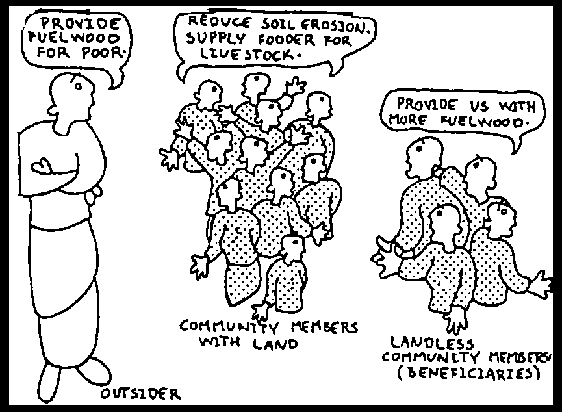
Good communication, good information, and imagination can lead to successful negotiations
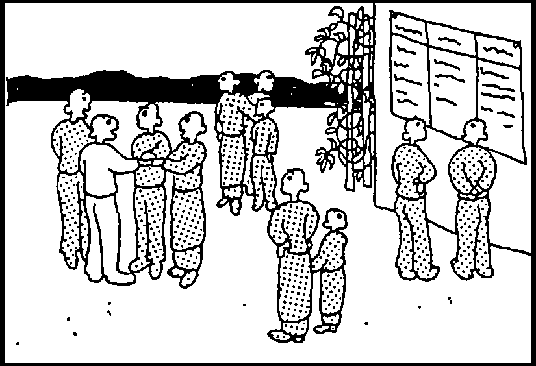
So that everyone can benefit
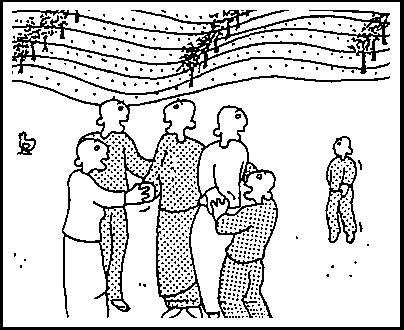
Builds on existing community skills
Over the years, communities develop their own unique ways to deal with problems. For the most part, these work well. But sometimes, when new, unexpected problems present themselves, or when the community social structure has broken down, the community is unable to cope. It is then that outsiders can intervene and introduce a new way to look at the situation.
Time to leave alone
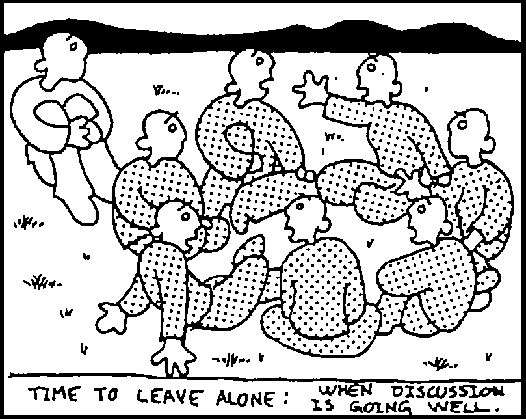
Time to intervene
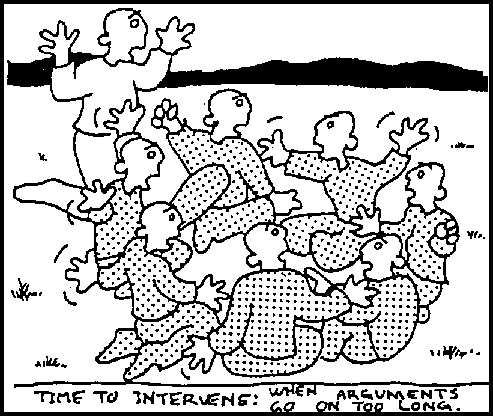
New skills can be introduced
For example, in the past, the community leader may have allocated land to individuals on the condition that they use it for growing crops, as land was in short supply. However, national government policies have changed, and now land is sold to individuals. Some of the new landowners do not belong to the community. They do not plant their lands, and as a result there is a shortage of food in the community. The traditional ways of dealing with this situation no longer work and new skills and strategies, which might include approaching the government with realistic options, must be explored.
Time to intervene
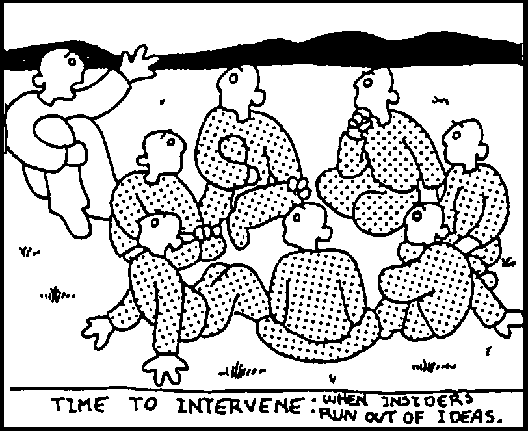
The basis for negotiation of conflicts
Participatory Assessment, through discussions of the proposed activities, identifies potential conflicts which can be dealt with before they become a problem.
For example, one proposed activity might be setting up a community nursery to produce nitrogen fixing tree species to plant with agricultural crops. These species will benefit only those who have land. The strategy proposed is that the community supply volunteer labour to the nursery. However, there is a strong possibility that those without land may be coerced into providing volunteer labour. Compensation, such as wages and perhaps free seedlings to plant around homes, must be negotiated from the beginning, or nursery labour may be withdrawn at a critical time.
Necessary conditions are determined
Participatory Assessment is built on "necessary conditions", factors which are important for successful completion of an activity. Using PAME, necessary conditions are discussed and ranked in order of importance for each specific activity. Information is then gathered to establish whether necessary conditions are present or possible. This information is used to eliminate those activities which have the least chance of success.
| Necessary conditions are the factors that must be present for a certain activity to happen. While some factors are more important than others, they must an exist. For example, the necessary conditions far growing a seedling are soil, water, seed, and light. Without seed, there an be no seedling, even if everything else is available. |
Necessary conditions can be created
If the necessary conditions are not present in the community, there is the possibility that they can be created.
If the activity were a community woodlot, the most important necessary condition could be available communal land. But, if this necessary condition is not present, alternatives can be explored. Private lands might be leased and the landlord might receive a portion of the wood produced.
2. Benefits of participatory assessment.
The beginning of the participatory relationship
Participatory Assessment is often the first interaction of outsiders with the community. It encourages the beginning of a participatory relationship between insiders and outsiders. First impressions are important and set the stage for the future.
Involvement of the community at an early stage
Participatory Assessment provides the community with the opportunity to decide, at the beginning, whether or not to accept the project as planned by outsiders or accept it with some modifications. When the community makes this first decision, there is a greater chance that they will be committed to what is, in actuality, their project.
Recognition of objectives provides the basis for negotiation
Encourages discussion of all relevant objectives so that potential conflicts can be identified and negotiated early, before they hinder success.
A learning experience
Participatory Assessment provides the opportunity for both insiders and outsiders to better understand the development process in which they are engaged.
Information for future reference is provided
The information from Participatory Assessment can complement baseline and evaluation information.
3. Steps to participatory assessment.
Outsiders and insiders (spokespersons for the community) should first discuss the purpose and benefits of a Participatory Assessment, and plan for the initial meeting if they decide to proceed.
A Participatory Assessment can begin with a community meeting, (see Tool 1: Group Meetings). Invite interested community members, the intended beneficiaries and others that may be affected by the project (such as nomadic herders or downstream communities).
The time required to do a Participatory Assessment will vary, depending on the community. It may take a large group meeting to go through the first analysis, another smaller team to gather information, and then another meeting of the large group to do a final analysis using the new information. In smaller communities, the people that are present may supply enough information, and the Participatory Assessment can be done in one meeting. Take as much time as is needed and try not to rush things.
The format for the Assessment Framework is presented throughout the following steps, and then completely on the last page of this chapter.
| First step 1 |
Establish insiders and outsiders objectives.
Insider and outsiders share their objectives. Outsiders state clearly what they can and cannot do.
Responsibilities should be clear
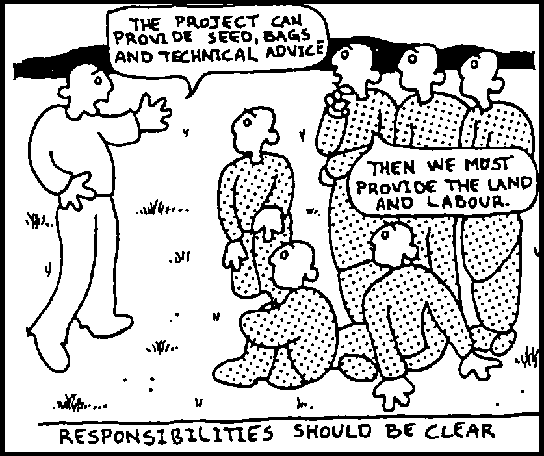
Insiders may take some time to discuss and determine their problems and solutions to establish their own objectives. Insiders and outsiders should clearly understand the responsibilities and inputs that are expected of them.
Whether the activities are initiated by insiders or outsiders, it will be insiders who must identify their own objectives. Some tools useful to this are:
| Tool 2 | Drawing and Discussion |
| Tool 4: | Flannel Boards |
| Tool 5: | Open-ended Stories |
| Tool 6: | Unserialized Posters |
| Second step 2 |
Describe three categories.
On a large sheet of paper, draw the Assessment Framework and explain the three categories.
Describe three categories
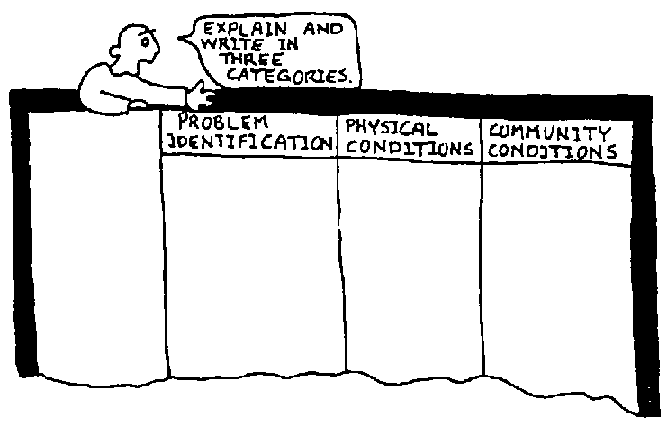
Problem identification
It is most important that insiders and outsiders have identified somewhat the same problem, that this problem is of high priority to insiders, and that the activities address the problems.
Problem identification is useful to both insiders and outsiders. It is the basis for determining objectives which are used to negotiate the best options for all.
Problem identification
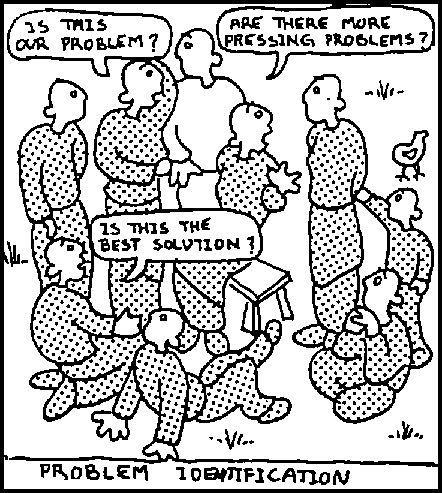
Physical conditions
Some important physical conditions must be present in order for activities to be carried out. For example, are land, water or near-by markets available to support activities?
It is important that the community identify physical conditions necessary for activities.
Physical conditions
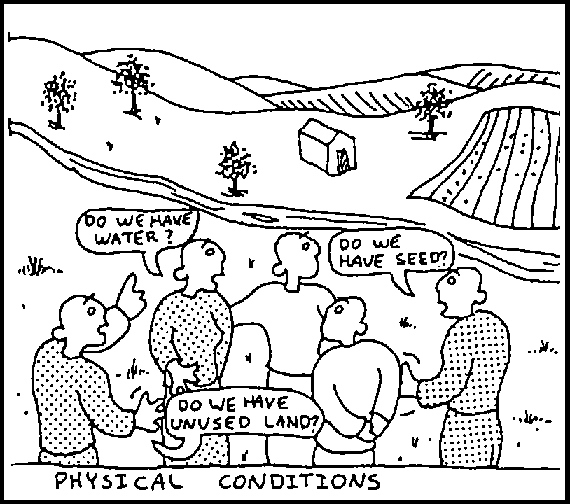
Community conditions
Consider the necessary socio-economic conditions. Are there community organizations that can implement the activities? Is there strong community leadership? Is there sufficient community labour available? What community skills are required? Are there social, religious, economic, class/caste, legal, and/or political conditions that might affect activities?
If a community organization is needed to carry out the activities an existing group may be able to handle the extra responsibility. If a new community structure is required, one of the existing successful community organizations can be used as a model.
Community conditions
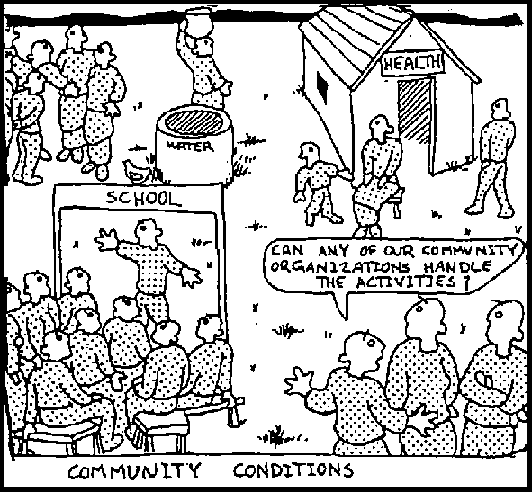
The community may be divided in such a way (class, caste, politics) that groups will not cooperate and may even openly oppose the project if they perceive that activities will not benefit them. Discussions of community constraints may bring up very sensitive issues. However, sensitive issues do not have to be challenged or resolved. They must only be recognized so that planning and negotiations take them into account.
| Third step 3 |
Identify activities within the three categories.
Within each of the three categories, the community will identify activities. These are written in the left hand column.
Identify activities within the three categories
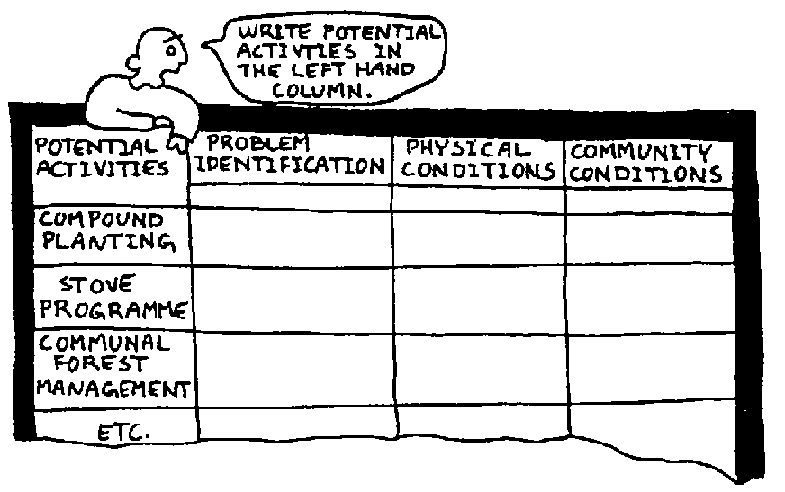
| Fourth step 4 |
Identify necessary conditions within each category for each activity.
Discuss and list all the conditions necessary in each category, and for each activity.
Identify necessary conditions within each category for each activity
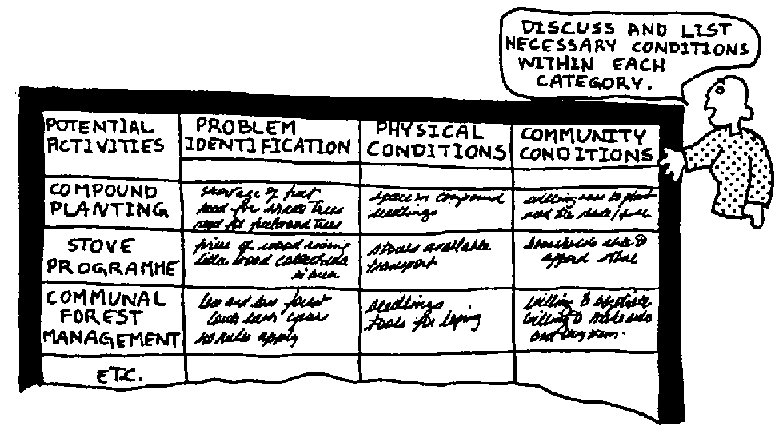
| Fifth step 5 |
Rank necessary conditions.
Have the group discuss and chose the most important (first) necessary condition in each category for each activity. Then choose the necessary condition next (second) in importance, then third and so on.
Omit those that the group does not consider important.
Rank necessary conditions.
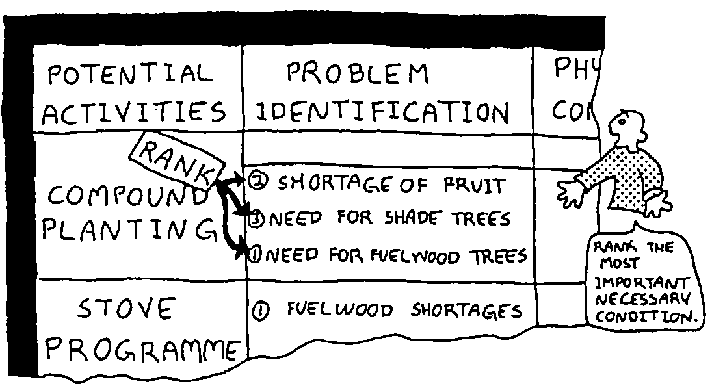
This kind of a framework should give a focus for discussion and a way to organize information. However, it may not work in each community. It may be too complicated, or just not the way some people organize their thoughts.
Field staff can try the framework with each other first. If it "works" (assists with understanding) then they might ask a few people from the community to try it, and give their feedback.
If the framework goes through these two "screens" it has a better chance of being useful to a larger group. If it doesn't "work", think of what may work better.
| Sixth step 6 |
Identifying information needed.
For each proposed activity, the necessary conditions are examined and the information required to see if these are present is identified. To do this, Activity Information Sheets, such as shown below, can be used for each activity proposed.
Identifying information needed
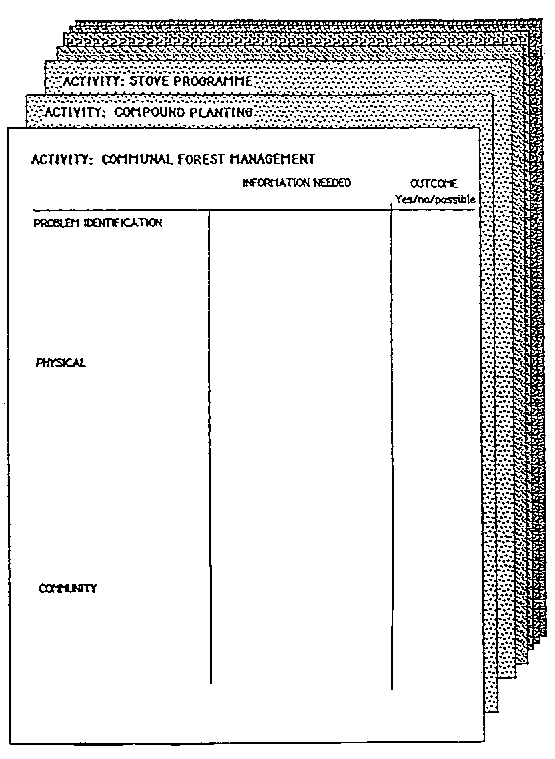
| Seventh step 7 |
Gather information.
The people at the meeting may have much of the information needed. Individuals can contribute information, and the validity, or truth, of individual information can be confirmed by the group.
If further information gathering is needed this can be done by designing teams for each activity, once the larger group has decided what information is needed.
Depending on the information that is needed, tools that might be helpful are:
| Tool 2 | Drawing and Discussion |
| Tool 4 | Flannel Boards |
| Tool 6 | Unserialized Posters |
| Tool 9 | Semi-structured Interviews |
| Tool 10 | Ranking, Rating and Sorting |
| Tool 15 | Maps and Mapping |
Gather information
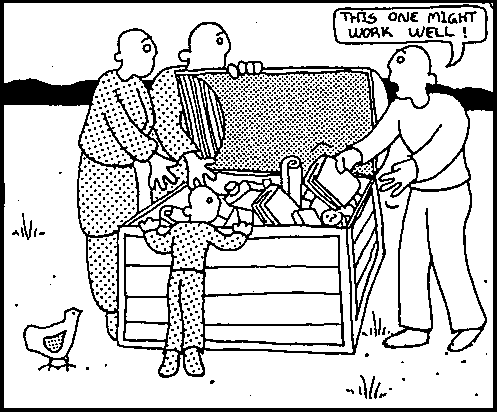
| Eighth step 8 |
Analyze information.
Returning to the larger group, the facilitator uses the Assessment Framework and the completed Activity Information Sheets to discuss and consider each activity in turn. The facilitator draws a line from left to right through each activity, indicating OK when necessary conditions are not present, or can be created, and indicating STOP when necessary conditions are not present and cannot be created. The lines with the OK right through to the end will be the activities that have all the conditions necessary to make them work.
Analyze information
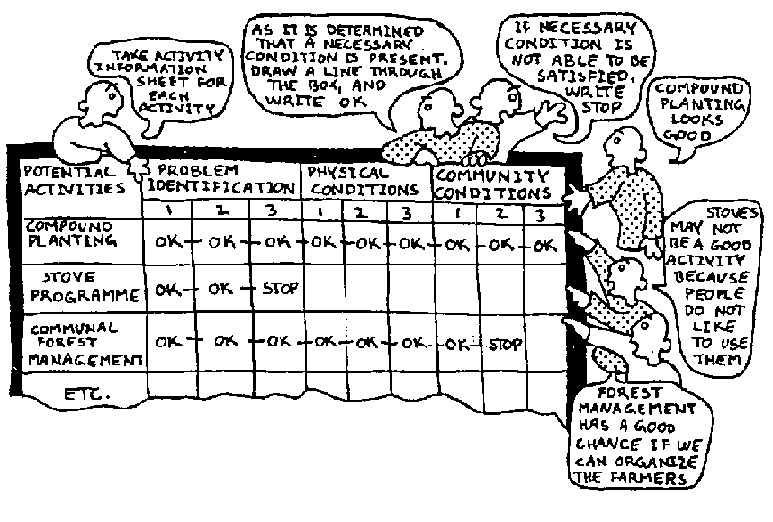
| The information from Participatory Assessment will be useful in the future, and should be stored in a safe place. |
The information from Participatory Assessment will be useful in the future, and should be stored in a safe place.
Chapter three: Participatory assessment
1. What is a participatory baseline?
2. The benefits of participatory baselines.
3. Steps to participatory baselines.
1. What is a participatory baseline?
A Participatory Baseline provides a description and information, mainly from the insiders perspective, of a specific situation. It is done so that activities can be focused, and change can be measured by comparison with similar situations at some future time. Information is identified and collected to describe the present situation as it specifically relates to the objectives. For example, if one of the objectives is to increase the supply of fuelwood to a community, the baseline information required might include:
What is the present fuelwood supply?
What is the source of the present fuelwood supply (local and/or imported)?
What is household fuelwood consumption?
Main purpose is to establish criteria to measure change
A Participatory Baseline enables insiders to measure and evaluate change in specific conditions providing a common understanding, from the beginning, of how change will be measured.
| Suppose you want to measure change in a family. It could be decided that this could best be done by measuring the number and growth of children. Measuring change in a family might include a photograph of the family at the beginning, and series of photographs or drawings over time. The photograph at the beginning would be a "baseline," while the other photographs would show change over time. |
In forestry, if the project objective is to plant trees in a school yard, measurement might be the number and growth of trees in the school yard. Drawings of the school yard before any project trees are planted, and each year throughout the activity can give a measurement of change.
What is a participatory baseline?
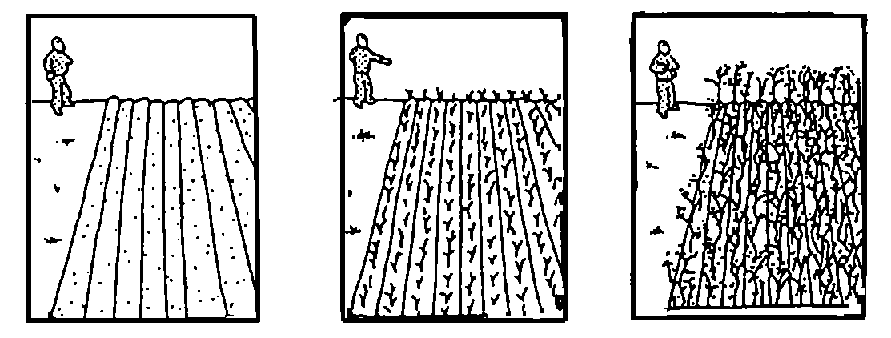
Provides information needed to start activities
A baseline can provide additional information about a specific topic. For example, a new activity to collect and sell forest products, might require a market survey.
2. The benefits of participatory baselines.
Community can, readily observe change
The communities discuss and agree upon ways to measure and observe change.
Provides a way to obtain information when needed
When insiders need specific information about an activity or proposed activity, the baseline method is a way for them to organize and obtain the information.
Complements baselines by outsiders
Baseline surveys by outsiders may be costly, and often the information is difficult to interpret. Participatory Baselines can complement and enrich outsider baselines by providing a comparison of the perceptions of insiders and outsiders.
Information is immediately useful to insiders and outsiders
Because insiders and outsiders are both involved in the planning and analysis of baselines, it is a learning experience for both groups. The information is understandable and can be used for confirmation of problem identification and solutions, planning project activities and identifying potential problems.
Can identify research needs
If it is not known what information is needed, and/or if information is not available, topics that need to be researched can be identified. This research can be done by insiders and outsiders (see Participatory Action Research Tool #12), or requested of local research agencies.
3. Steps to participatory baselines.
Participatory Baselines can be done with the whole community or with the beneficiary group. This will depend on the size of the community and their interest. If there is a large community group, it may be best if responsibilities for baseline are delegated to a few people, (a baseline team). The baseline team will be directed by the baseline questions developed by the larger group, and report the results back to them.
The facilitating role of the outsiders should be discussed. Outsiders generally have access to information from urban markets, libraries, other agencies and government sources which can be of use to communities.
A baseline framework is used to plan information gathering and analysis. The following steps describe sections of the framework.
| First step 1 |
Discuss the purpose of a baseline.
Describe baseline information to the group. Discuss with them the benefits of baseline information. Will this kind of information be beneficial to them? If they decide to proceed, what do they want to know? Do they want to measure progress or obtain information about a specific issue?
Discuss the purpose of a baseline
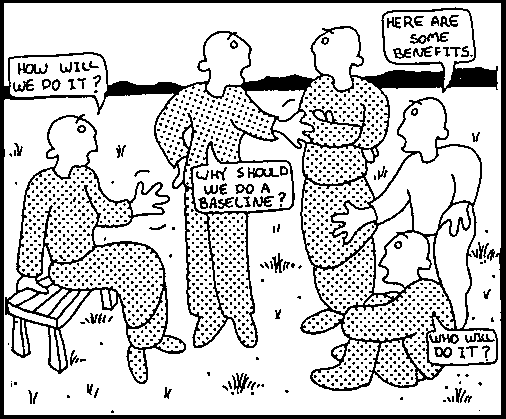
| Second step 2 |
Review objectives and activities.
If baseline is being done for the purpose of being able to measure change at a future date, then objectives and activities can be reviewed. These may have been established during a Participatory Assessment. If not, the objectives and activities established by the outsiders can be reviewed and discussed.
If a baseline is being done to obtain specific information for a new activity or because of a problem, reviewing of the central questions can be useful.
Review objectives and activities
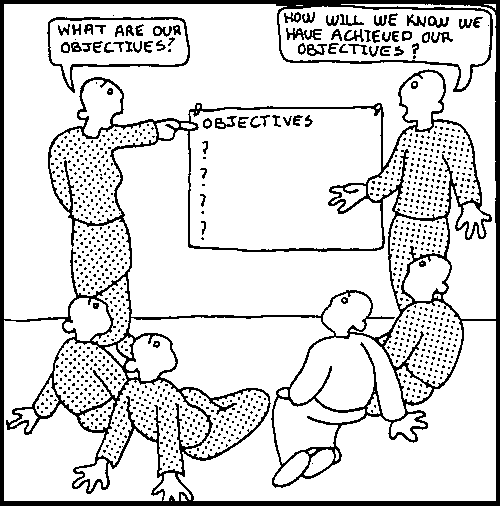
| Third step 3 |
Establish baseline questions.
Once the reason for the baseline has been determined, the group must decide what information will tell them what they want to know. This can be discussed by the group, and then later prioritized if there are too many questions. If the group is large, they may wish at this point, to delegate responsibility to a baseline team.
| Direct and Indirect Indicators Direct indicators are pieces of information that expressly relate to what is being measured. For example, if information on crop yields are required then crop yields are measured. Indirect indicators are essential pieces of information chosen from amongst many possible pieces of information to serve as substitutes or proxys to answer questions and/or respond to statements that are difficult to measure. For example, instead of the direct indicator of income, indirect indicators of poverty chosen by insiders might be:
Key indicators are essential pieces of information that open doors to understanding. Indicators can be compared to road signs. Road signs give information that tell the traveler how far it is to a certain town. The traveler can then estimate the time it will take Establishing indicators may take some time, but experience Shows that this is lime well spent Three important questions to be answered are:
Establishing good indicators will reduce the amount of information that needs to be collected . |
Direct and indirect indicators
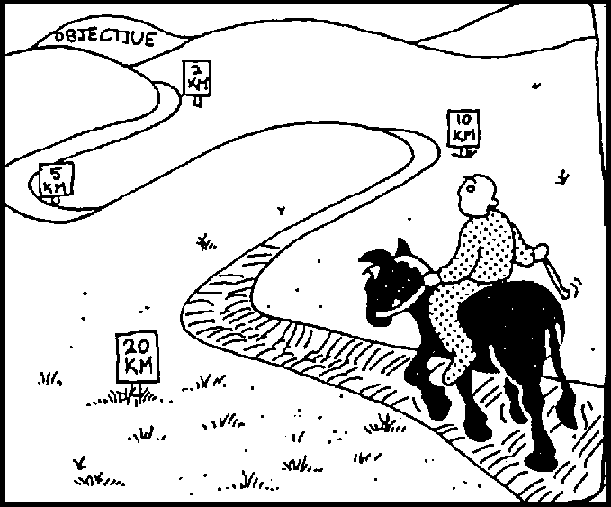
| Fourth step 4 |
Choose key indicators.
To establish direct or indirect indicators, for each baseline question think of the indicators that are possible. Will the indicators answer the questions with the level of accuracy required? Record indicators for each baseline question.
| Fifth step 5 |
Identify the information sources and tools for baseline questions.
For each baseline question decide where and how the information can best be obtained. Some information may be available from a secondary source (such as a recent agricultural survey), while other information will have to be collected.
Fifth step 5
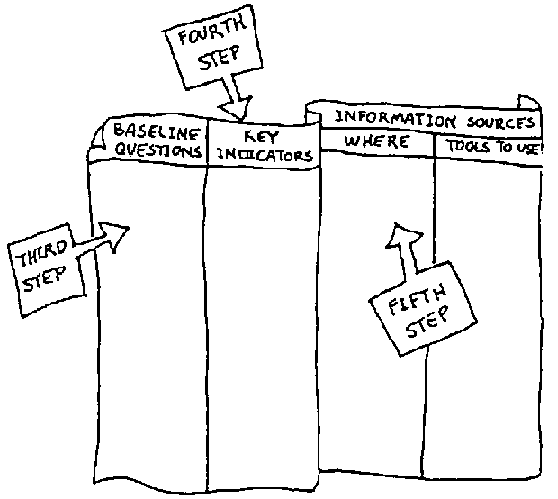
It may be that many baseline questions can be answered using the same information gathering tool. Some of the information gathering tools that can facilitate participatory monitoring are:
| Tool 2 | Drawing and Discussion |
| Tool 4 | Flannel Boards |
| Tool 5 | Open-ended Stories |
| Tool 9 | Semi-structured Interviews |
| Tool 10 | Ranking, Rating and Sorting |
| Tool 14 | Maps and Mapping |
Decide on skills and labour required to obtain information.
Participatory Baselines may require the assistance of people with specific abilities, such as interview skills, math skills, artistic skills and/or dramatic skills. It will also require a certain amount of labour (time) from people.
The group (or small team) must decide which skills and labour (resources) are available within the community, and what other outside resources are available to them. They might ask the questions:
What resources do we need?
What resources do we have, or can we develop?
What other resources do we need to get?
Sixth step 6
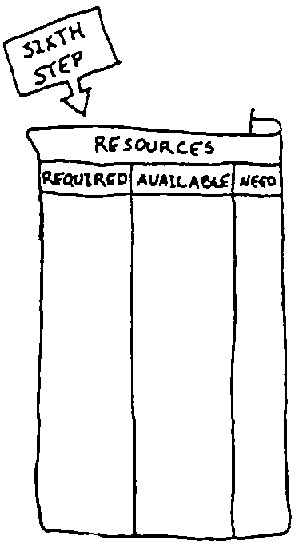
| Seventh step 7 |
Decide when information gathering can be done.
The time for the baseline must be determined taking into account factors such as: seasonal constraints (planting and harvesting times); religious holidays; field staff availability; and community labour demands.
For each key indicator, or baseline question the group decides approximately how long each task will take and when it will be done.
Seventh step 7
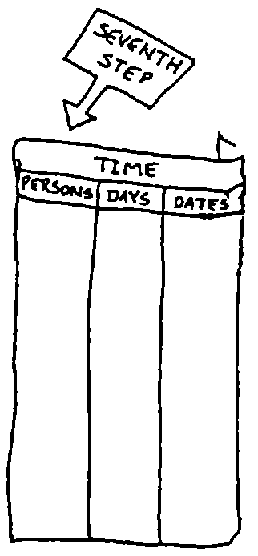
| Eighth step 8 |
Decide who will gather information.
When the specific dates, the time and the skills required are known, the tasks can then be delegated to individuals or small working groups.
| Ninth step 9 |
Decide what to do with the information.
Depending on the purpose of the baseline, the information can be analyzed and stored, analyzed and presented, or roughly analyzed and stored.
Ninth step 9
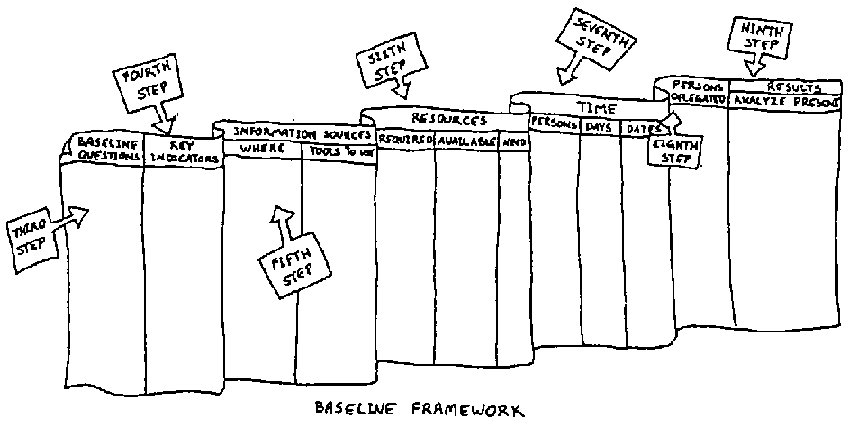
Chapters Seven and Eight describe ways to analyze and present information.
| The information from Participatory Baselines will be useful in the future. Store the information in a safe place. |